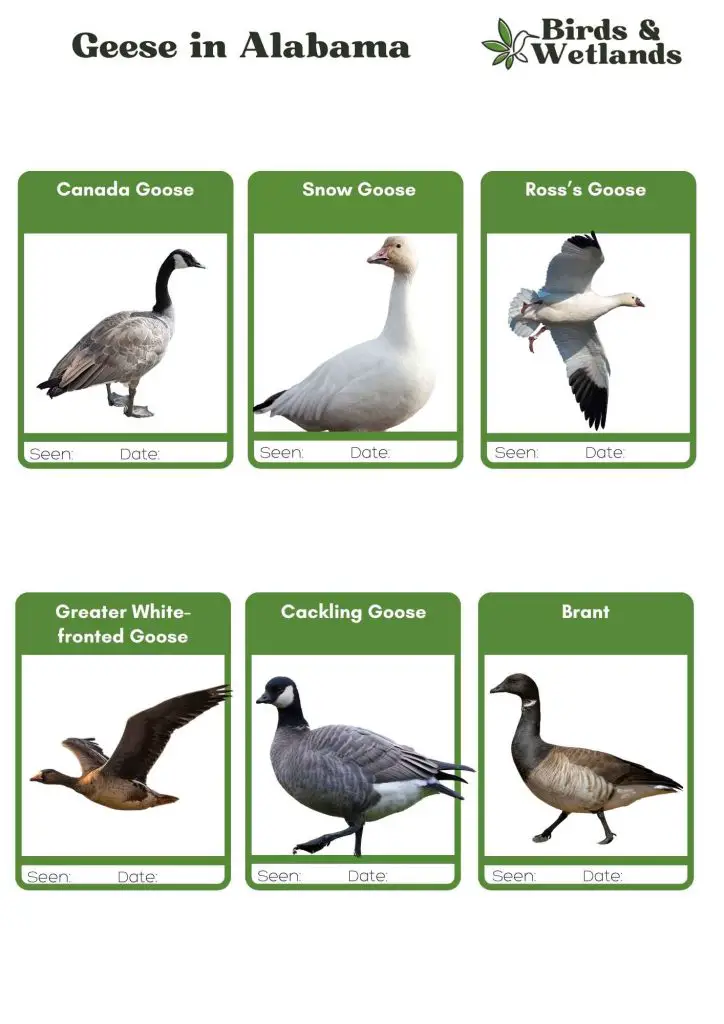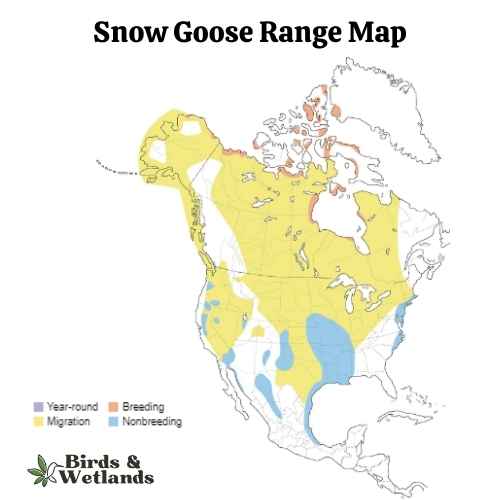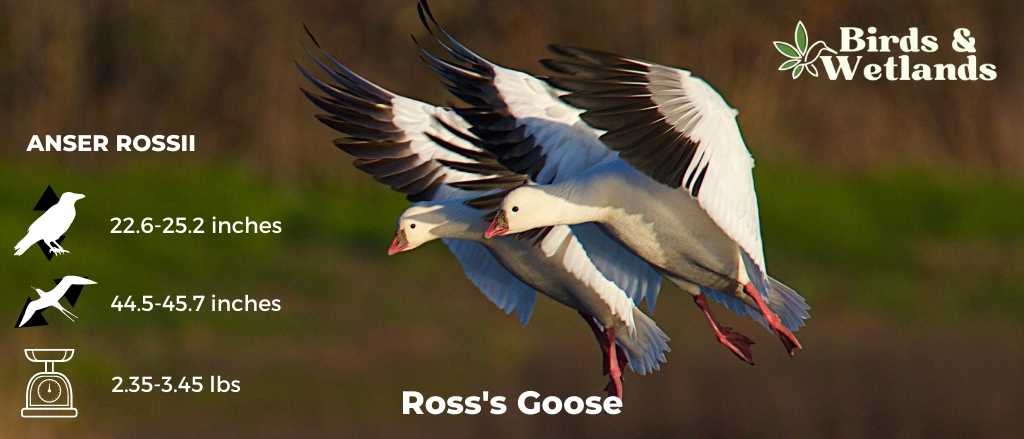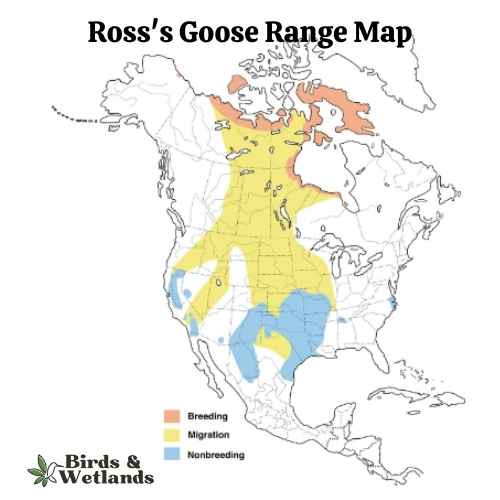Whether you are interested in geese watching or hunting, in this guide, we will provide a complete guide to the geese in Alabama from the different types of geese that can be found in the state, to their behavior and diet. Of the nine types of geese in Northern America, 6 are found in Alabama.
By the end of this guide, you will have a better understanding of these amazing creatures and how to best enjoy them in Alabama, and if you are interested in other birds in Alabama, check out our state guide.
What Geese Are in Alabama?
There are three main types of resident geese that can be found in Alabama: Canada goose, snow goose and Ross’s goose. These resident flocks are generally found in the northern and central parts of the state on golf courses, parks and gardens.
The resident Canada geese are often seen as a nuisance in some parts, as their numbers are so abundant and the Wildlife service often does issue permits to keep the numbers of the resident birds in check.
- Snow Goose
- Ross’s Goose
- Canada Goose
Also seen but not resident
- Greater white-fronted goose
- Brant
- Cackling goose
Neighboring Tennessee has similar geese species, whilst Georgia has a smaller range of geese and Mississippi has less geese species, and Florida has three types of geese.

Snow Goose


Snow Goose Sound
Scientific Name: Anser caerulescens
Length: 25 to 31 in
Wingspan: 53 to 65 in
Weight: 4.5 to 6.0
The Snow Goose is a large species of waterfowl known for its vibrant white plumage and significant migratory flights.
Appearance: True to their name, Snow Geese are predominantly white with black wingtips. They also have a pink bill, pink legs and feet. A color morph, known as the “Blue Goose,” displays a bluish-gray body with a white head, but is considered the same species.
Diet: Snow Geese primarily feed on plant matter, such as grasses, sedges, and small grains. They can often be seen in large flocks foraging in fields and marshes, and during migration and winter, they can cause considerable damage to agricultural fields due to their feeding habits.
Reproduction: Snow Geese typically nest on the tundra, near water bodies. The female builds the nest and lays a clutch of about 3 to 5 eggs, which she incubates alone for approximately three weeks. Once hatched, the goslings can feed themselves but stay with their parents for protection until they can fly.
Ross’s Goose


Listen
Scientific Name: Anser rossii
Length: 23.2-25.2
Wingspan: 44.5-45.7 in
Weight:42.3-55.3 oz
The Ross’s Goose is a small species of waterfowl often found in North America’s tundra and wetland habitats.
Appearance: Known for its compact size, the Ross’s Goose is mostly white with black wingtips. It features a short, stubby bill and a rounded head. One key identifying feature is the blueish gray base of its bill, which has a warty structure during the breeding season.
Diet: This goose feeds mainly on vegetation, including seeds, leaves, and roots of grasses and sedges. During winter and migration, they also consume grains and seeds from agricultural fields.
Reproduction: The Ross’s Goose nests on the ground, often in colonies. The female lays a clutch of 2 to 5 eggs which she incubates for around three weeks. The young geese, known as goslings, are precocial – they can walk, swim, and feed themselves shortly after hatching, although they stay with their parents until they learn to fly.
Canada Goose


Canada Goose Sound
Scientific Name: Branta canadensis
Length: 30 to 43 in
Wingspan: 50–73 in
Weight: 5.7–14.3 lb
The Canada Goose is a large, well-known species of waterfowl noted for its distinctive appearance, familiar “honk,” and migratory behavior.
Appearance: Both male and female Canada Geese have a similar appearance, featuring a black head and neck with distinctive white patches on the cheeks and chin. The body is primarily brown with a lighter, often white, underbelly.
Diet: Canada Geese primarily feed on plant matter, including grasses, aquatic vegetation, and grains. They can often be seen grazing in parks, lawns, and fields, as well as dabbling in water bodies.
Reproduction: Canada Geese typically nest on the ground near water bodies, often on islands or other isolated areas to avoid predators. The female lays a clutch of about 4 to 6 eggs, which she incubates alone for around a month.
A sub species of the Canada goose is the Giant Canada Goose, which are exceptionall large birds.
Best spots to see Geese in Alabama
Wheeler National Wildlife Refuge: Located along the Tennessee River near Decatur, Wheeler NWR is a haven for migratory birds, including geese. The refuge provides diverse wetland habitats and open fields that attract a variety of waterfowl species.
Mobile Bay: The coastal areas around Mobile Bay, including Dauphin Island, offer opportunities to observe geese and other waterfowl. The bay provides a mix of marshes, estuaries, and open water habitats that attract migratory geese.
Lake Guntersville: As Alabama’s largest lake, Lake Guntersville offers ample opportunities for birdwatching. Its vast expanse and surrounding woodlands provide suitable habitats for various waterfowl species, including geese.
These locations have a history of attracting waterfowl, including geese, but the presence and abundance of geese can vary depending on the time of year and other factors. It’s always recommended to check with local birding communities or park authorities for the latest updates and guidance on observing geese in Alabama.
| Neighboring State | Best Spots to See Geese |
|---|---|
| Tennessee Geese | 1. Reelfoot Lake 2. Great Smoky Mountains National Park 3. Radnor Lake State Park |
| Mississippi Geese | 1. Mississippi Sandhill Crane National Wildlife Refuge 2. Noxubee National Wildlife Refuge 3. Grand Bay National Wildlife Refuge |
| Georgia Geese | 1. Okefenokee National Wildlife Refuge 2. Jekyll Island 3. Piedmont National Wildlife Refuge |
| Florida Geese | 1. Merritt Island National Wildlife Refuge 2. Paynes Prairie Preserve State Park 3. Lake Kissimmee State Park |
| Louisiana Geese | 1. Sabine National Wildlife Refuge 2. Lake Martin 3. Catahoula National Wildlife Refuge |
Hunting Geese
If you are planning on hunting geese then see theAlabama Waterfowl Hunting Guide. The Alabama waterfowl hunting guide sets out the same shooting hours and bag limits allowed by the Alabama department.
Can you shoot A Goose in Alabama?
Yes, with a few conditions. You cannot hunt in the summer breeding grounds or the molting period and you must have a valid hunting license and you may only hunt during the open season which typically runs from September to February, and during the day shooting hours.
The current conditions (2022) in the hunting season are:
ALL GEESE: – The total bag limit of 5 dark geese (Canada, Whitefronted, Brant) can not include more than 1 Brant. Additionally, a total bag limit of 5 light geese (Snow, Blue, Ross’s) may be harvested per day.
DARK GEESE: (Canada, White-fronted, Brant) – 5 a Day. The total bag limit of 5 shall not include more than 3 Canada Geese or 1 Brant.
LIGHT GEESE: (Snow, Blue, Ross’s) – The total bag limit shall be 5 a day.
Always check for the up to date limits as the USDA wildlife services strive to keep the natural resources like fish and wildlife well stocked.
Where can I hunt geese in Alabama?
You’ll find them on any number of our state’s wildlife management areas, which are operated by the Wildlife and Freshwater Fisheries Division. Here you can enjoy public access for fishing or hunting; it’s your choice!
Is there a goose hunting season in Alabama?
Yes, generally the regular waterfowl season runs from October to February and the state runs an aggregate bag limit.
There are large flocks of geese present throughout Alabama, providing adequate opportunity for hunting and viewing. Geese are generally found in the northern and central parts of the state with three main types of resident geese: Canada goose, snow goose and Ross’s goose. A female goose can have over 40 offspring, so numbers are healthy and continuing to rise.

